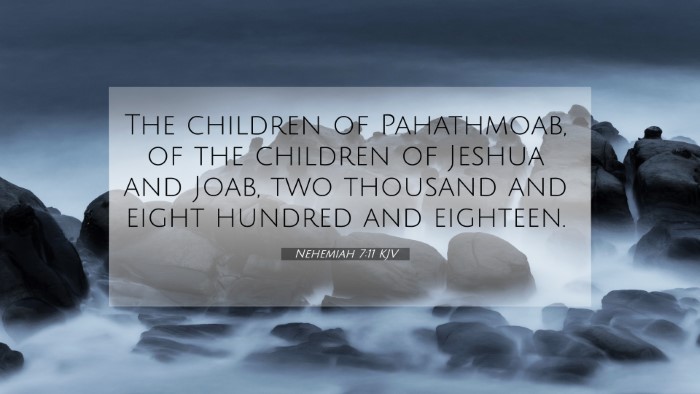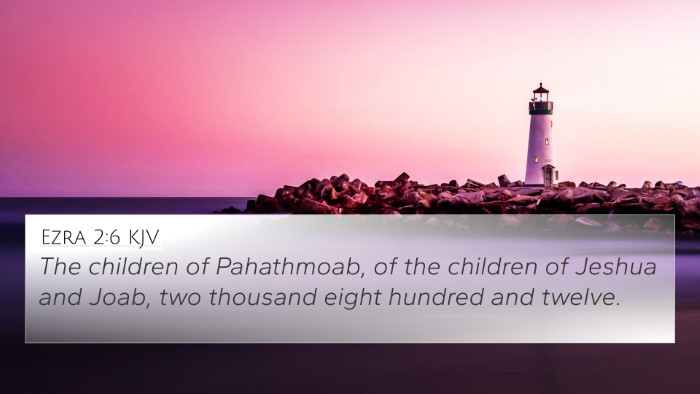Understanding Nehemiah 7:11
Nehemiah 7:11 states: "The children of Pahathmoab, of the children of Jeshua and Joab, two thousand eight hundred and eighteen." This passage is part of the census taken after the Israelites returned from Babylonian exile, highlighting the names and numbers of those who settled in Jerusalem. Below, we delve into its significance and explore cross-references that provide a broader context.
Key Insights from Public Domain Commentaries
-
Matthew Henry's Commentary
Matthew Henry emphasizes the importance of this census as a way of organizing the returned exiles and reinstating their identity and community after years of displacement. The list serves not only as a record but also as a means to remind the people of their heritage and the faithfulness of God in restoring them to their homeland.
-
Albert Barnes' Notes on the Bible
Barnes highlights the names mentioned in the census, specifically those of Jeshua and Joab as leaders, underscoring the significance of leadership in the restoration process of Israel. He notes that the number recorded reflects both the fulfillment of God’s promise to bring His people back and the structural organization necessary for rebuilding the community.
-
Adam Clarke's Commentary
Clarke points out that the detailed records, including names and numbers, reflect a formal administrative approach to the rebuilding efforts. This detail serves as a testament to the diligence and careful planning that was necessary as the community sought to establish itself both spiritually and socially in Jerusalem.
Thematic Connections and Bible Cross-References
Nehemiah 7:11 not only serves to catalog the returning exiles but also interlinks with various other scriptures that address themes of restoration, community identity, and divine faithfulness. Below are relevant cross-references:
- Ezra 2:6-8: Provides a parallel census detailing the returning exiles, reinforcing the importance of numbers in establishing community.
- Nehemiah 7:4: Highlights the need for security and the rebuilding of the walls of Jerusalem, linking to the need for a populace to defend the city.
- Deuteronomy 30:3-5: Engages God’s promise of restoration for His people, echoing throughout the returning verses.
- Jeremiah 29:10-14: Speaks of the hope and future God has for His people in exile, setting a backdrop for the return.
- 1 Chronicles 9:2: Lists those who returned from exile, providing context for Nehemiah's records.
- Isaiah 44:28: Mentions Cyrus as a shepherd who would fulfill God's purpose, linking to the Babylonian context of exile.
- Ezra 1:1-4: Details King Cyrus’s decree allowing the exiles to return, establishing the historical backdrop of Nehemiah's work.
- Nehemiah 12:1-26: Lists the priests and Levites who returned, connecting back to the need for spiritual leadership in rebuilding.
- Romans 11:1-2: Speaks of God's enduring relationship with His people, relating to the themes of return and identity.
- Hebrews 11:9-10: Ties the theme of faith and promise to the acts of returning and establishing a city for God’s name.
Importance of Cross-Referencing Biblical Texts
Cross-references play a crucial role in understanding the interconnectedness of biblical themes. Here, we emphasize how to utilize these references in studies:
- Tools for Bible Cross-Referencing: Utilizing concordances and study guides can provide insights into thematic connections throughout the Bible.
- Bible Cross-Reference Guide: Many editions of the Bible include margins that outline cross-references, aiding in thematic exploration.
- How to Use Bible Cross-References: Engage with verses by juxtaposing them against related scriptures to draw deeper understanding.
- Cross-Referencing Bible Study Methods: Consider group studies where individuals present connections they’ve found, fostering collective insights.
- Bible Reference Resources: Many online tools and applications allow easy access to cross-referencing possibilities, enriching study sessions.
- Bible Chain References: Link verses thematically through study chains, connecting various scriptural points.
- Comparative Study of Pauline Epistles: Understanding Paul's letters can be enhanced by comparing themes with Old Testament texts like Nehemiah.
- Interpreting Biblical Themes Through Cross-References: Explore various themes, like restoration, by mapping names or events across scriptures.
Conclusion
Nehemiah 7:11 serves as a vital link in the narrative of restoration for the Israelites post-exile. By utilizing cross-references, readers can uncover profound truths and connections within the Bible, demonstrating God's faithfulness to His people. The detailed record in this verse encourages believers today to remember their heritage and the importance of community in their spiritual journeys.





